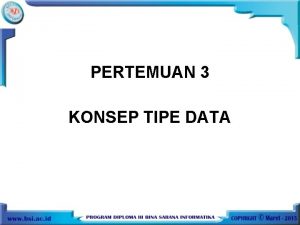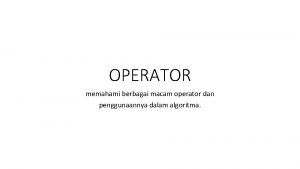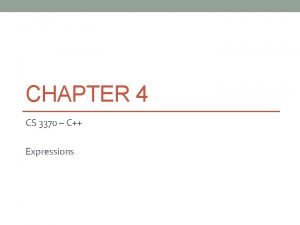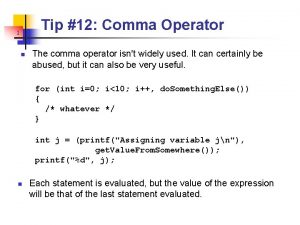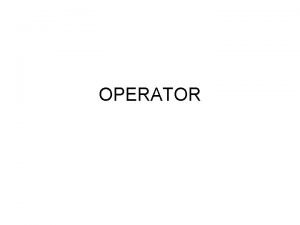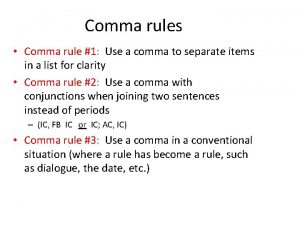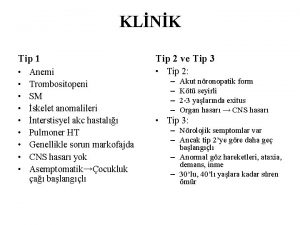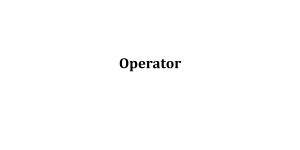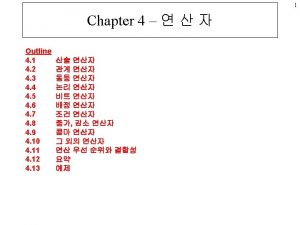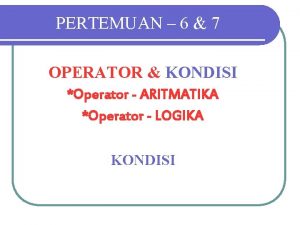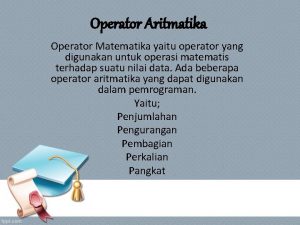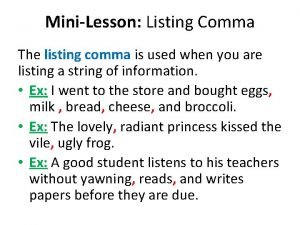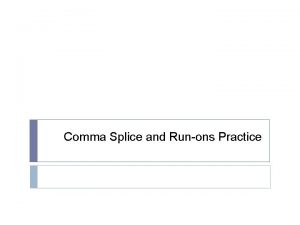Tip 12 Comma Operator 1 n The comma
































- Slides: 32

Tip #12: Comma Operator 1 n The comma operator isn't widely used. It can certainly be abused, but it can also be very useful. for (int i=0; i<10; i++, do. Something. Else()) { /* whatever */ } int j = (printf("Assigning variable jn"), get. Value. From. Somewhere()); printf("%d", j); n Each statement is evaluated, but the value of the expression will be that of the last statement evaluated.

Semaphores n A semaphore is a protected variable whose value is accessed and altered by the operations signal (produce) and wait (consume). n n n A semaphore is used for controlling access to a common resource in a concurrent system, such as multi-threading. The value of a semaphore is the number of available resources and may be used to synchronize various task activities. A useful way to think of a semaphore is as a record of how many units of a particular resource are available, coupled with operations to safely consume those units, and, if necessary, wait until a unit of the resource becomes available.

Mutexes n A mutex (or binary semaphore) is a locking mechanism used to synchronize access to a resource (such as code). n n n Only one task can acquire the mutex. It means there is ownership associated with mutex, and only the owner can release the lock (mutex). A mutex is designed to protect critical data so that only one thread can access it at the same time, such as a section of code or access to a variable.

Semaphores 4 n What does it mean to be autonomous? n n n Disable interrupts (only works on uni-processor) Hardware: test-and-set, exchange Software solutions (Decker) What does it mean to be synchronous? What are the different types of semaphores? n Binary semaphore – 1 resource, 2 states n n n 0 = nothing produced, maybe tasks in queue 1 = something produced, no tasks in queue Counting semaphore – 1 resource, multiple copies n n n 0 = nothing produced, nothing in queue -n = nothing produced, n tasks queued +n = n items produced, no tasks in queue

Semaphores 5 SEM_SIGNAL - Producer void sem. Signal. Binary(Semaphore* semaphore) // signal binary semaphore { semaphore->state = 1; // produce (signal) binary semaphore tid = de. Q(semaphore->queue, -1); // dequeue blocked task if (tid < 0) return; // if empty, return semaphore->state = 0; // blocked task consumes semaphore Produce tcb[tid]. state = S_READY; // ready task for execution en. Q(rq, tid, tcb[tid]. priority); // move task to ready. Consume queue return; void sem. Signal. Counting(Semaphore* semaphore) // signal counting }semaphore // end sem. Signal. Binary { if (++semaphore->state > 0) return; // return if nothing in queue tid = de. Q(semaphore->queue, -1); // dequeue task tcb[tid]. state = S_READY; // ready task for execution en. Q(rq, tid, tcb[tid]. priority); // move task to ready queue Produce & Consume return; } // end sem. Signal. Counting

Semaphores 6 SEM_WAIT - Consumer void sem. Wait. Binary(Semaphore* semaphore) // wait binary semaphore { if (semaphore->state == 0) // signaled? { tcb[cur. Task]. state = S_BLOCKED; // n, change task state to blocked en. Q(semaphore->queue, de. Q(rq, cur. Task)); // move from ready to blocked queue swap. Task(); // reschedule the tasks } semaphore->state = 0; // consume semaphore return; // return w/no block sem. Wait. Counting(Semaphore* semaphore) // wait counting }void // end sem. Wait. Binary semaphore { semaphore->state--; // consume if (semaphore->state < 0) { tcb[cur. Task]. state = S_BLOCKED; // change task state to blocked en. Q(semaphore->queue, de. Q(rq, cur. Task)); // move from ready to blocked quueu swap. Task(); // reschedule the tasks } return; // return w/semaphore

Project 2 Assignment Step 3: 5 -State Scheduling 7 n Add priority queue to semaphore struct n n n // semaphore // link to next semaphore // semaphore name (malloc) // state (count) // type (binary/counting) // tid of creator // blocked queue Malloc semaphore queue in create. Semaphore n n typedef struct semaphore { struct semaphore* sem. Link; char* name; int state; int type; int task. Num; PQueue q; } Semaphore; semaphore->q = (int*)malloc((MAX_TASKS + 1) * sizeof(int)); semaphore->q[0] = 0; // init queue sem. Wait: de. Queue current task from ready queue and en. Queue in semaphore block queue sem. Signal: de. Queue task from semaphore block queue and en. Queue in ready queue.

P 2 - Tasking 5 -State Scheduler create. Task() swap. Task(); sem. Wait(s); sem. Signal(s); sem. Try. Lock(s); dispatch() Ready Queue Running swap. Task() ig m. S se it( ) New SWAP SEM_WAIT(s) SEM_SIGNAL(s) SEM_TRYLOCK(s) Wa #define l() na sem 8 Blocked Queues kill. Task() Exit

Scheduling 9 Task Scheduling Scheduler / Dispatcher Ready Priority Queue Executing SWAP SEM_SIGNAL Semaphore Priority Queue … SEM_WAIT

Project 2 Assignment Step 4 a: Counting Semaphore 10 n Add counting functionality to semaphores n n n Add a 10 second timer (tics 10 sec) counting semaphore to the polling routine (os 345 interrupts. c). n n os 345 semaphores. c: sem. Signal, sem. Wait, sem. Try. Lock Replace goto temp; #include <time. h> header. Call the C function time(time_t *timer). sem. Signal the tics 10 sec semaphore every 10 seconds. Create a reentrant high priority timing task that n n blocks (SEM_WAIT) on the 10 second timer semaphore (tics 10 sec). when activated, outputs a message with the current task number and time and then blocks again.

P 2 - Tasking 11 Task Control Block (tcb) State = { NEW, READY, RUNNING, BLOCKED, EXIT } // task control block Priority = { LOW, MED, HIGH, VERY_HIGH, HIGHEST } typedef struct // task control block { char* name; // task name int (*task)(int, char**); // task address int state; // task state (P 2) int priority; // task priority (P 2) int argc; // task argument count (P 1) char** argv; // task argument pointers (P 1) int signal; // task signals (P 1) // void (*sig. Cont. Handler)(void); // task my. SIGCONT handler void (*sig. Int. Handler)(void); // task my. SIGINT handler // void (*sig. Kill. Handler)(void); // task my. SIGKILL handler // void (*sig. Term. Handler)(void); // task my. SIGTERM handler Pending semaphore when blocked. // void (*sig. Tstp. Handler)(void); // task my. SIGTSTP handler TID parent; // task parent int RPT; // task root page table (P 4) int cdir; // task directory (P 6) Semaphore *event; // blocked task semaphore (P 2) void* stack; // task stack (P 1) jmp_buf context; // task context pointer (P 1) } TCB;

Project 2 Assignment Step 4 b: List Tasks 12 n Modify the list tasks command to n n Display all tasks in all system queues in execution/priority order List task name, if the task is ready, paused, executing, or blocked, and the task priority. If the task is blocked, list the reason for the block. Use the project 2 command to schedule timer tasks 1 through 9, 2 signal tasks and 2 “Im. Alive” tasks. n n n The tics 10 sec task about the current time every 10 seconds in a round robin order. (Round Robin) The “Im. Alive” tasks will periodically say hello. (Blocking) The high priority “Signal” tasks should respond immediately when semaphore signaled. (Priority)

Project 2 Assignment Step 4 c: Verification 13 Demo n # Task Name Priority Time slice Blocking Semaphore 0 CLI w/pseudo-input interrupts 5 1 in. Buffer. Ready 1 -9 Ten. Seconds 10 1 tics 10 sec 10 s. Task 1 20 1 s. Task 10 11 s. Task 2 20 1 s. Task 11 12 Im. Alive 1 1 None 13 Im. Alive 1 1 None

Bounded Buffer 14 Bounded Buffer Solution Shared semaphore: empty = n, full = 0, mutex = 1; repeat produce an item in nextp wait(empty); wait(mutex); repeat wait(full); wait(mutex); remove an item from buffer place it in nextc add nextp to the buffer signal(mutex); signal(full); until false signal(mutex); signal(empty); consume the item in nextc until false

Reader/Writer Readers and Writers Problem 15 n Data object is shared (file, memory, registers) n n n Conditions needing to be satisfied: n n n many processes that only read data (readers) many processes that only write data (writers) many can read at the same time (patron of library) only one writer at a time (librarian) no one allowed to read while someone is writing Different from producer/consumer (general case with mutual exclusion of critical section) – possible for more efficient solution if only writers write and readers read. Solutions result in reader or writer priority

Reader/Writer Shared Data 16 n What are some characteristics of shared data objects (files, data bases, critical code)? n n What conditions / advantages / problems arise when there is concurrent reading and writing? n n n Many processes only need mutual exclusion of critical sections (producer/consumer, mutexes) many processes only read data (readers) many processes only write data (writers) many can read at the same time (patrons of library) only one writer at a time (librarians) no one allowed to read while someone is writing possible for more efficient solution than producer / consumer if only writers write and readers read. Who should have priority, readers or writers?

Reader/Writer 17 Readers/Writers Semaphore rmutex=1, wmutex = 1; integer readcount = 0; Only one writer at a time while(true) { wait(wmutex); <write to the data object> Writer signal(wmutex); }; while(true) { Readers have priority! Who has priority (writersorsubject to Reader Writer? starvation!) Reader More than one reader at a time }; The first reader makes sure no one can write wait(rmutex); readcount++; if (readcount == 1) wait(wmutex); signal(rmutex); Last one out allows <read the data> writing again wait(rmutex); readcount--; if (readcount == 0) signal(wmutex); signal(rmutex);

What is the purpose of the following semaphores? 18 Semaphore outer. Q, rsem, rmutex, wsem = 1; // READER 6 // WRITER while(true) { wait(outer. Q); wait(rsem); wait(rmutex); readcnt++ if (readcnt == 1) wait(wsem); signal(rmutex); signal(rsem); signal(outer. Q); 3 while(true) { wait(wmutex); writecnt++; if (writecnt == 1) wait(rsem); signal(wmutex); wait(wsem); WRITE 1 signal(wsem); wait(wmutex); writecnt--; if (writecnt == 0) signal(rsem); signal(wmutex); READ }; wait(rmutex); readcnt--; if(readcnt == 0) signal(wsem); signal(rmutex); 2 4 }; 5

Reader/Writer 19 Writers/Readers Semaphore outer. Q, rsem, rmutex, wsem = 1; while(true) Additional readers queue here allowing { wait(outer. Q); { wait(wmutex); writers to jump ahead wait(rsem); writecnt++; of the readers wait(rmutex); if (writecnt == 1) readcnt++ wait(rsem); if (readcnt == 1) signal(wmutex); Disable wait(wsem); writers signal(rmutex); Wait here until signal(rsem); WRITE all readers done, signal(outer. Q); as well as Once a writer wants to signal(wsem); multiple writers write – no new readers READ wait(wmutex); allowed writecnt--; wait(rmutex); if (writecnt == 0) readcnt--; signal(rsem); if(readcnt == 0) signal(wmutex); signal(wsem); }; Last reader out Last writer out allows writers signal(rmutex); allows readers };

Barbershop Problem 20 n 3 barbers, each with a barber chair n n n Sofa can hold 4 customers Maximum of 20 in shop n n n Cashier Entrance Customers arrive randomly Customers wait outside if necessary Standing room area Exit Sofa When a chair is empty: n n n Barber chairs Haircuts vary in time Customer sitting longest on sofa is served Customer standing the longest sits down After haircut, customer pays cashier at cash register n n n Barbers have to cut hair and cashier Customer waits for receipt Upon exit, new customer allowed in shop

Barbershop 21 Fair Barbershop procedure customer; var custnr: integer; begin wait ( max_capacity ); // enter_shop wait( mutex 1 ); count : = count + 1; custnr : = count; signal( mutex 1 ); wait( sofa ); // sit on sofa wait( barber_chair ); // get up from sofa signal( sofa ); // sit in barber chair wait( mutex 2 ); enqueue 1( custnr ); signal( cust_ready ); signal( mutex 2 ); wait( finished[custnr] ); // leave barber chair signal( leave_b_chair ); // pay signal( payment ); wait( receipt ); // exit shop signal( max_capacity procedure barber; var b_cust: integer begin repeat // get customer wait( cust_ready ); wait( mutex 2 ); dequeue 1( b_cust ); signal( mutex 2 ); wait( coord ); // cut hair signal( coord ); signal( finished[b_cust] ); wait( leave_b_chair ); signal( barber_chair ); forever end; procedure cashier; begin repeat wait( payment ); wait( coord ); // accept payment signal( coord ); signal( receipt ); forever end; Barber chairs Cashier Entrance Standing room area Exit Sofa max_capacity: semaphore (: =20); sofa: semaphore (: =4); barber_chair, coord: semaphore (: =3); mutex 1, mutex 2: semaphore (: =1); cust_ready, leave_b_chair: semaphore (: =0) payment, receipt: semaphore (: =0) finished: array [1. . 50] of semaphore (: =0); count: integer;

22 Jurassic Park Visitors try to enter the Jurassic Park at random times. (Only a set number of visitors may be in the park at any one time – OSHA requirements!) Upon being allowed in the park, a visitor must get in line to purchase a ticket. When the tour car pulls into the unloading station, the visitors exit the tour car. and the driver goes to sleep awaiting new duties. The tour car pulls forward to be loaded again. After visiting the museum, the visitor gets in the tour car line to wait until permitted to board a tour car. (As a visitor boards a tour car, he returns his ticket. ) After visiting the gift shop, the visitors exit the park. When the touring car is filled with visitors and a driver is obtained, the car enters Jurassic Park and runs a guided tour through the park. After the visitors exit a tour car, they get into the gift shop line until they can visit the gift shop. After successfully obtaining a ticket from a driver, the visitor gets in the museum line and visits the museum. (A limited number of visitors are allowed in the museum as well as the gift shop. )

23 Jurassic Park procedure visitor; var visitor_id: integer; begin wait ( max_capacity ); // enter_park wait ( park. Mutex ); num. Outside. Park--; num. In. Park-++; signal ( park. Mutex ); // get a ticket wait ( request. Ticket. Mutex ); signal ( need. Ticket ); signal ( wakeup. Driver ); wait ( take. Ticket ); signal ( request. Ticket. Mutex ); // visit museum // get in car line // wait for a seat wait ( need_visitor ); signal ( visitor_ready ); pass_to_car ( visitor_id ); wait ( ride_over ); // give back ticket // visit gift shop // exit park signal ( max_capacity ); procedure car; var car. ID: integer begin repeat // fill 3 car seats for (NUM_SEATS) { wait ( fill. Seat[car. ID] ); signal ( need_visitor ); wait ( visitor_ready ); save_Visitor( visitor. ID ); signal ( seat. Filled[car. ID] ); } pass_to_park( car. Done ); signal ( car. Ready ); // enjoy ride wait ( car. Done ); signal ( each visitor. ID ); forever end; max_capacity: semaphore (: =20); park. Mutex, request. Ticket. Mutex: semaphore (: =1); need. Ticket, wait. Ticket: semaphore (: =0) procedure driver; var car. ID: integer begin repeat wait ( wakeup. Driver ); if ( trylock ( need_ticket )) { signal (take. Ticket); } else { signal ( driver_ready ); wait ( ride_over ); { forever end;

Message Passing 24 n Shared memory is useful in a threaded environment n n n Inter-process communication (IPC) used by processes n n n Single atomic variables (semaphores, modes) Memory mapping (data structures, messages) Test-and-set (atomic instructions) Fast – do not require data movement (reference) for processes inside the same computer for processes in a distributed system Message passing used by distributed systems (networks) n n n send(destination, message) post(destination, message) receive(source, message)

Message Passing Synchronization 25 n For the sender: it is more natural not to be blocked n n n can send several messages to multiple destinations sender usually expects acknowledgment of message receipt (in case receiver fails) Post. Message() is asynchronous – returns immediately Send. Message() is synchronous –block until message delivered and processed For the receiver: it is more natural to be blocked after issuing Receive. Message() n n the receiver usually needs the info before proceeding but could be blocked indefinitely if sender process fails before sending reply

Message Passing Addressing 26 n Direct addressing: n n n when a specific process identifier is used for source/destination but it might be impossible to specify the source ahead of time (ex: a print server) Indirect addressing (more convenient): n n messages are sent to a shared mailbox which consists of a queue of messages senders place messages in the mailbox, receivers pick them up

Message Passing Mailboxes and Ports 27 n A mailbox can be private n n A mailbox can be shared among several senders and receivers n n one sender/receiver pair OS may then allow the use of message types (for selection) Port: a mailbox associated with one receiver and multiple senders n used for client/server application: the receiver is the server

Message Passing 28 n n Port/Mailbox Ownership A port is usually owned and created by the receiving process The port is destroyed when the receiver terminates The OS creates a mailbox on behalf of a process (which becomes the owner) The mailbox is destroyed at the owner’s request or when the owner terminates

Monitors 29 n A programming-language construct that provides equivalent functionality to that of semaphores n n A monitor is a software module containing: n n n ME threads that wait (block) for true conditions. Thread-safe class (wrapped by mutual exclusive conditions) Concurrent Pascal, Pascal-Plus, Modula, Java one or more procedures, an initialization sequence, and local data variables Mutex (lock) object and condition variables Condition variable: n n n Container of threads that are waiting on a certain condition. Threads temporarily give up exclusive access in order to wait for some condition to be met. Local variables accessible only by monitor’s procedures A process enters the monitor by invoking one of its procedures Only one process can be in the monitor at any one time

Monitor 30 Monitor for the P/C problem Monitor boundedbuffer: Make threading system buffer: array[0. . k-1] of items; release all locks; nextin: =0, nextout: =0, count: =0: integer; sleep until condition is met. notfull, notempty: condition; Produce(v): if (count = k) cwait(notfull); buffer[nextin] : = v; nextin : = nextin+1 mod k; count++; csignal(notempty); Consume(v): if (count = 0) cwait(notempty); v : = buffer[nextout]; nextout : = nextout+1 mod k; count--; csignal(notfull); Signal a consumer thread or all consumer threads that are blocked waiting for non-empty buffer.

Conclusion 31 n n Semaphores are a powerful tool for enforcing mutual exclusion and to coordinate processes. When wait(S) and signal(S) are scattered among several processes n n Difficult to understand their effects. Difficult to test. Monitors make classes thread-safe and mutual exclusion more controllable. Usage must be correct in all the processes (everyone has to play by the rules). n One bad (or malicious) process can fail the entire collection of processes

32
 Comma comma comma chameleon meme
Comma comma comma chameleon meme Sıcak evin direği tıp tıp eder yüreği
Sıcak evin direği tıp tıp eder yüreği Pada tipe data boolean, berlaku operator-operator...
Pada tipe data boolean, berlaku operator-operator... Pada tipe data boolean, berlaku operator-operator...
Pada tipe data boolean, berlaku operator-operator... Logical operators priority in c
Logical operators priority in c Unary operator and binary operator
Unary operator and binary operator Comma operator in c
Comma operator in c Comma operator in c
Comma operator in c Làm thế nào để 102-1=99
Làm thế nào để 102-1=99 Hổ sinh sản vào mùa nào
Hổ sinh sản vào mùa nào Lời thề hippocrates
Lời thề hippocrates Chụp phim tư thế worms-breton
Chụp phim tư thế worms-breton đại từ thay thế
đại từ thay thế Quá trình desamine hóa có thể tạo ra
Quá trình desamine hóa có thể tạo ra Công thức tính thế năng
Công thức tính thế năng Thế nào là mạng điện lắp đặt kiểu nổi
Thế nào là mạng điện lắp đặt kiểu nổi Các loại đột biến cấu trúc nhiễm sắc thể
Các loại đột biến cấu trúc nhiễm sắc thể Nguyên nhân của sự mỏi cơ sinh 8
Nguyên nhân của sự mỏi cơ sinh 8 Bổ thể
Bổ thể Vẽ hình chiếu đứng bằng cạnh của vật thể
Vẽ hình chiếu đứng bằng cạnh của vật thể Phản ứng thế ankan
Phản ứng thế ankan Môn thể thao bắt đầu bằng chữ f
Môn thể thao bắt đầu bằng chữ f Thiếu nhi thế giới liên hoan
Thiếu nhi thế giới liên hoan Sự nuôi và dạy con của hươu
Sự nuôi và dạy con của hươu điện thế nghỉ
điện thế nghỉ Bài hát chúa yêu trần thế alleluia
Bài hát chúa yêu trần thế alleluia Một số thể thơ truyền thống
Một số thể thơ truyền thống Trời xanh đây là của chúng ta thể thơ
Trời xanh đây là của chúng ta thể thơ Số nguyên là gì
Số nguyên là gì Tỉ lệ cơ thể trẻ em
Tỉ lệ cơ thể trẻ em Fecboak
Fecboak Các châu lục và đại dương trên thế giới
Các châu lục và đại dương trên thế giới Thế nào là hệ số cao nhất
Thế nào là hệ số cao nhất


